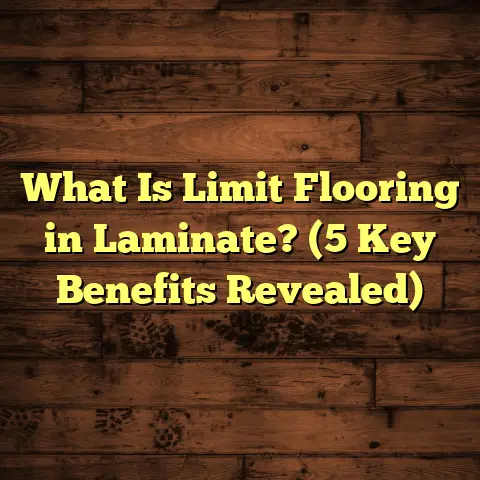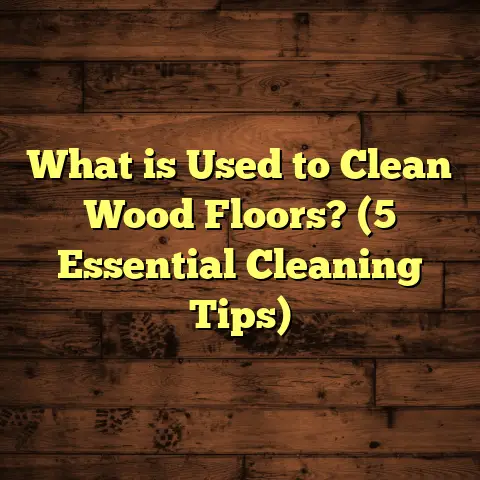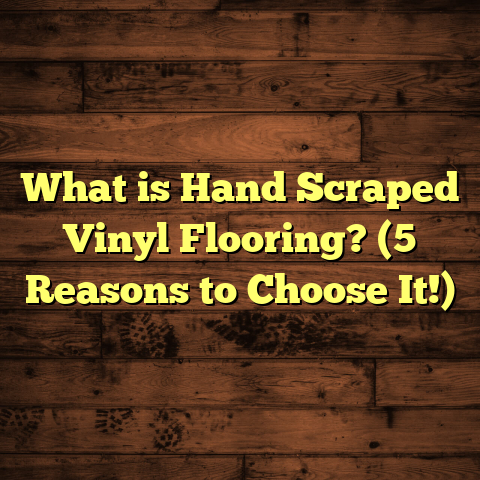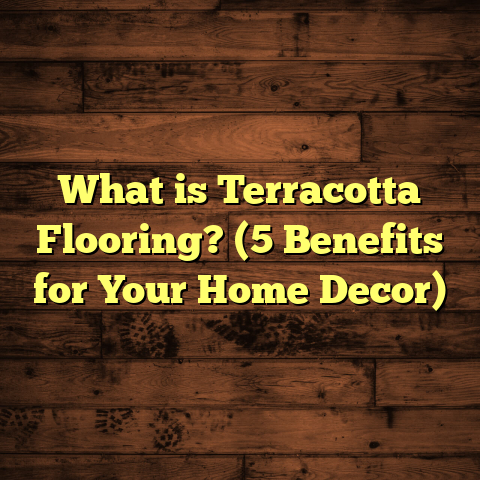What is Trending in Flooring? (5 Styles You Can’t Miss)
I still remember the first time I stepped into a home where the flooring just stopped me in my tracks. It wasn’t flashy or over-the-top, but there was something about the wide, smooth planks that felt like they were inviting me to slow down and stay awhile. The floor wasn’t just a surface; it was a feeling underfoot that echoed throughout the entire space. Since then, I’ve come to realize that the right flooring isn’t just about covering a room—it’s about setting a lifestyle tone for how we live and move in our spaces.
Whether you’re lounging on a lazy Sunday morning, chasing kids around the living room, or hosting an intimate dinner party, your flooring plays a big role in shaping the mood and function of your home. So what flooring styles are making waves now? Let me walk you through five styles I’ve seen rise sharply in popularity—styles that blend beauty, durability, sustainability, and modern manufacturing innovation. These are the ones I believe you truly can’t miss if you’re thinking about updating your floors.
What is Trending in Flooring?
When I talk about “trending” flooring styles, I’m referring to those designs and materials that have seen noticeable increases in demand recently. These trends reflect more than just aesthetic preferences—they mirror changes in technology, lifestyle needs, environmental awareness, and practical functionality.
Over the years working as a flooring contractor, I’ve watched how trends shift with consumer priorities and advancements in manufacturing processes. Flooring today is no longer just about looks; it’s about performance, comfort, sustainability, and smart installation methods that save time and money.
So what exactly is trending? It’s everything from wider hardwood planks that visually open up rooms to vinyl options that combine style with water resistance. It’s cork flooring gaining fans for its eco-credentials and comfort. It’s terrazzo making its way back with a modern twist. And it’s reclaimed wood telling stories through every scratch and knot.
Each of these styles has its own story—technical specs, manufacturing secrets, real-life applications—that make them stand out. I want to share not only what these trends are but why they’re worth considering based on real data and my personal experience in the field.
1. Wide Plank Hardwood: Bigger Boards, Bigger Impact
Let me start with wide plank hardwood because it was that style that first made me appreciate how significant flooring really can be.
The Appeal of Wide Planks
Imagine walking into a room where the wood boards stretch out in wide ribbons across the floor. Instead of the busier look of narrow strips, wide planks create a seamless flow that feels expansive and calming. It’s like the floor breathes along with the rest of your home.
The standard width for hardwood planks has traditionally been between 2 and 3 inches. Wide plank hardwood breaks this mold with boards measuring anywhere from 5 to 12 inches wide. This larger scale creates fewer seams, which means less visual interruption and a more organic feel to your space.
For bigger rooms or open-concept layouts, wide planks enhance the sense of spaciousness. But even smaller rooms can benefit if you want a minimalist look without overcrowding your floor with lines.
Technical Details & Manufacturing
Wide plank hardwood is mostly made from stable hardwood species like white oak, hickory, maple, and walnut. The manufacturing process starts with selecting high-quality logs free of major defects because wider boards tend to show imperfections more clearly.
The wood is then kiln-dried carefully to reduce moisture content to around 6-8%. This drying step is crucial because wood reacts strongly to humidity changes; too much moisture can cause warping or cupping after installation.
Once dried, the boards are milled with precision saws to ensure flatness and uniform thickness. Wide planks require tighter milling tolerances because any bowing or twisting can be more pronounced than with narrow boards.
Some manufacturers add hand-scraping or wire-brushing techniques to give the surface texture and character—kind of like adding personality without losing durability.
Installation Considerations
Installing wide plank hardwood requires a stable subfloor because wider boards are less forgiving to uneven surfaces. Subfloor preparation often involves leveling compounds or plywood overlays.
Because of the size and weight of these planks, installation tends to be more labor-intensive than narrow boards. But many contractors—including myself—consider the extra effort worth it given the end result.
Engineered wide plank hardwood is another option I often recommend. It features a top layer of hardwood bonded over multiple layers of plywood or HDF (High-Density Fiberboard). This layered structure provides enhanced stability against moisture fluctuations without sacrificing the authentic wood look.
My Personal Experience
One project that sticks out involved renovating a century-old farmhouse. The owners wanted floors that would honor the home’s history but also feel fresh and modern. We chose 7-inch wide white oak engineered planks finished with matte oil-based polyurethane. The look was warm but understated, perfect for their style.
The wide planks visually connected rooms in their open layout while nodding to traditional craftsmanship. The client told me later it completely changed how they felt living there—more relaxed and grounded.
Data Insights
According to the National Wood Flooring Association (NWFA), sales of wide plank hardwood increased by 18% annually over the last three years in residential settings. This growth is driven by consumer desire for floors that combine rustic charm with contemporary simplicity.
2. Luxury Vinyl Plank (LVP): The Versatile Warrior
Luxury Vinyl Plank (LVP) has jumped from being an underestimated choice to a flooring superstar in recent years—and I’ve seen first-hand why it’s so popular.
What Makes LVP Stand Out?
LVP offers the look of hardwood or stone at a fraction of the cost and with some unique benefits you don’t get from natural materials. It’s waterproof, scratch-resistant, easy to clean, and comes in tons of textures and finishes.
If you have pets or kids—or live in humid climates—LVP can be a game-changer since it doesn’t swell or warp like wood does when exposed to moisture.
How Is LVP Made?
LVP’s manufacturing involves several layers:
- Wear Layer: A transparent top coat made from urethane or aluminum oxide protects against scratches and dents.
- Printed Design Layer: High-resolution digital images replicate wood grain or stone patterns with impressive realism.
- Core Layer: This is usually PVC (polyvinyl chloride) or WPC (wood plastic composite). WPC cores add sturdiness and some sound insulation.
- Backing Layer: Adds structural support and moisture resistance.
The wear layer thickness varies—higher-end LVPs might have 20 mil (0.02 inches) or more for extra durability.
Installation Types
Most LVPs use click-lock systems, making DIY installation easier compared to glue-down vinyl sheets or hardwood nails. Floating floors with LVP also allow installation over many existing surfaces like concrete or tile.
I’ve installed LVP in basements where moisture is a constant concern—wood floors were off the table but LVP provided both style and function without worry about water damage.
Cost & Maintenance
LVP costs vary widely but generally range from $2 to $7 per square foot for materials alone. When you add installation and underlayment, total costs often fall between $5-$12 per square foot—still more affordable than many hardwood options.
Maintenance is simple: regular sweeping and occasional mopping with gentle cleaners keep LVP looking new. Unlike wood floors, no refinishing is needed over time.
Industry Trends & Data
The Freedonia Group reported vinyl flooring demand growing at roughly 7% annually across North America recently. Waterproof features combined with realistic designs are major drivers behind this trend.
I think vinyl’s versatility offers a rare combination: it works well in high-traffic areas, wet zones like kitchens and bathrooms, and even stylish living spaces thanks to its upgraded appearance.
3. Cork Flooring: Comfort Meets Sustainability
Cork flooring has quietly risen in popularity among homeowners who want something warm underfoot but also environmentally responsible.
What is Cork Flooring?
Cork comes from the bark of cork oak trees primarily harvested in Portugal and Spain. The bark regenerates naturally every 9 years without harming the tree—making cork one of the most renewable flooring materials available.
The harvested bark is ground into granules which are then mixed with adhesives and pressed into tiles or planks. After curing, they’re sanded smooth and finished with sealants for wear resistance.
Why Cork?
Cork floors are naturally soft and cushioned because of their cellular structure filled with air pockets. This makes standing or walking on cork easier on joints compared to harder surfaces like tile or wood.
It also offers excellent thermal insulation—your feet feel warmer during winter—and sound absorption properties that reduce noise within rooms.
Durability & Maintenance
Modern cork flooring comes sealed with polyurethane coatings or aluminum oxide finishes that protect against moisture and wear.
While cork isn’t as hard as oak or tile, it can last decades if properly maintained. Repairing minor dents or scratches is relatively straightforward with sanding and refinishing.
My Experience With Cork
One mom I worked with wanted safe flooring for her toddler’s playroom as well as an eco-friendly choice she could feel good about. Cork was perfect: soft for falls but durable enough for toys and furniture.
She also loved how quiet it kept noise between floors in her apartment building—a huge bonus for urban living.
Environmental Impact
From an environmental perspective, cork harvesting supports biodiversity by preserving cork oak forests that serve as habitats for endangered species such as the Iberian lynx.
A life cycle analysis published by Sustainability Journal (2023) found cork production emits significantly fewer greenhouse gases compared to hardwood flooring production—up to 40% less CO₂ equivalent per square meter installed.
4. Terrazzo: The Comeback Kid With Contemporary Flair
Terrazzo has been around for centuries but is experiencing a renaissance as designers rediscover its versatility combined with modern manufacturing techniques.
What Exactly is Terrazzo?
Terrazzo consists of chips—marble, quartz, granite, glass—set into a cementitious or epoxy resin base that’s polished smooth after curing. The result is a seamless surface speckled with colorful stones that’s both artistic and durable.
Manufacturing Process
Traditional terrazzo uses cement as a binder:
- Place divider strips on subfloor to outline sections.
- Pour cement mixed with chips.
- Once dry, grind down surface with diamond abrasives.
- Polish until smooth.
- Seal for stain resistance.
Modern epoxy terrazzo uses resin instead of cement:
- Allows thinner pours (around 1/4 inch thick).
- Offers brighter colors.
- Faster curing times.
- Higher chemical resistance.
Why Terrazzo Works Today
Its durability makes terrazzo great for high-traffic areas like kitchens, hallways, retail spaces—even bathrooms since epoxy versions resist moisture well.
Customization is another plus: you can choose chip types (glass gives sparkle; marble adds classic elegance), sizes from tiny flecks to large chunks, plus base color for endless design possibilities.
My Personal Take
I installed terrazzo floors in a trendy café downtown last year where foot traffic was intense but aesthetics mattered just as much. The floor still looks flawless months later despite constant use—and cleanup is simple since spills don’t stain easily.
Market Trends
According to Flooring Today magazine data between 2021-2024, terrazzo installations rose over 25% in commercial urban projects due to its long lifespan and design flexibility combined with lower maintenance costs compared to natural stone tile.
5. Reclaimed Wood Flooring: Stories Beneath Your Feet
Reclaimed wood flooring ties us back to history—and that’s why it’s capturing hearts these days among homeowners who want authentic character plus environmental responsibility.
What Is Reclaimed Wood?
This type of flooring comes from salvaged wood taken from old barns, factories, warehouses, or even demolished homes instead of cutting down new trees.
The wood carries marks of its past: nail holes, weathered grain patterns, even discoloration from years of use—all contributing to unique character impossible to replicate artificially.
Processing Steps & Preparation
Reclaimed wood needs careful preparation:
- Removing nails and hardware safely.
- Cleaning out dirt and contaminants.
- Milling boards back into consistent planks.
- Applying finishes that protect while preserving patina.
Sometimes manufacturers blend reclaimed wood with new wood layers (engineered reclaimed) for stability while keeping vintage looks intact.
Why Choose Reclaimed?
Beyond looks, reclaimed wood reduces demand for virgin timber—important given deforestation concerns globally—and often comes from slow-growth old-growth trees offering denser grain than modern fast-grown lumber.
Experience From The Field
I installed reclaimed pine flooring for a couple renovating their country cabin last fall. They loved hearing stories about where each plank came from while feeling connected to nature through their floor’s imperfections.
Once sealed properly with matte urethane finishes, the floor stood up well against heavy use without losing its charm over time.
Demand & Statistics
According to data from the American Hardwood Export Council, demand for reclaimed wood flooring has increased nearly 30% over five years in custom home builds seeking environmentally conscious materials combined with unique aesthetics.
How I Use Tools Like FloorTally for Accurate Cost Estimation
If you’ve ever started pricing out flooring projects yourself, you know how quickly costs can get confusing—especially when factoring in material quality differences, labor rates by region, waste allowance during installation, delivery fees, underlayment needs—the list goes on.
That’s why I rely on FloorTally when planning projects nowadays—it helps me keep everything clear without juggling multiple spreadsheets or vendor quotes all at once.
It lets me input local labor costs based on zip code data along with material prices updated frequently from suppliers near me. Plus it calculates waste percentages automatically depending on flooring type—important because cutting wide plank boards can lead to more offcuts than narrower ones.
Using it also means I can quickly compare scenarios: natural hardwood vs vinyl plank vs engineered cork by price per square foot including installation. That way my clients get realistic budgets upfront rather than surprises halfway through their build.
This tool has saved me hours on estimations alone while improving accuracy—which is crucial when managing expectations around budget and timelines in residential renovations or commercial builds alike.
Final Thoughts on These Flooring Styles Shaping Homes Now
Flooring isn’t just something you put down then forget—it changes how your space feels every day you step inside. Wide plank hardwood invites calm luxury; luxury vinyl plank balances style with practicality; cork brings softness plus eco-consciousness; terrazzo delivers lasting artistry; reclaimed wood connects us to history beneath our feet—all five offer something unique depending on what matters most to you.
As someone who has helped countless homeowners make these choices firsthand, I can say each trend reflects shifts not only in design but how we live smarter—balancing beauty with durability and sustainability with convenience.
Have you noticed any of these trends catching your eye? Or maybe you’ve tried one already? I’d love to hear what worked—or didn’t—in your experience!
And if budgeting or figuring out installation logistics ever feels overwhelming (it often does), don’t hesitate to reach out for advice or try tools like FloorTally yourself—they really help take guesswork out of this important part of your project planning journey.
Your floors deserve thoughtful choices—they set your foundation literally and figuratively—for everything you do at home every day.





